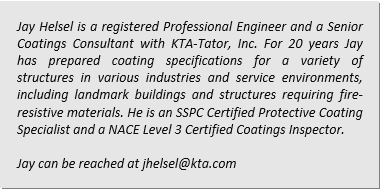Fire resistive coatings generally refers to a broad group of materials known as sprayed fire resistive materials (SFRM). These coatings provide protection to structural steel in buildings and other structures by serving as an insulative layer in the event of a fire. The coatings are rated by how long they provide such protection, typically from 1/2 hour to 4 hours. However, SFRMs may not provide significant corrosion protection to steel. When corrosion protection is required and the fire resistive coating alone is not suitable for the service environment, an appropriate primer and/or finish coat may also be needed.
In the United States, Underwriters Laboratories (UL) is a recognized authority that evaluates and approves SFRMs for a certain fire rating. The approval for a coating encompasses important details, including the types and sizes of steel members (e.g., beam, column, angle, etc.) it may be used on and the required coating thickness. A primer and exterior finish coat may also be required as part of the system. Failure to comply with these design requirements would likely void the UL approval for the coating, and more importantly, could jeopardize the coating’s fire resistive properties. Note that the use of any primer(s) should be approved by the manufacturer of the SFRM.
Approvals and testing of SFRMs are divided into two categories: for cellulosic fires or hydrocarbon fueled fires, which burn at much higher temperatures. Fire resistance for cellulosic fires is tested per ANSI/UL 263, “Standard for Fire Tests of Building Construction and Materials.” The test temperature increases gradually over time and reaches 2000°F at 4 hours.
Testing for resistance to hydrocarbon fires follows ANSI/UL 1709, “Fire Tests of Structural Steel Protected for Resistance to Rapid Temperature Rise Fires.” In this testing, a temperature of 2000°F is reached within five minutes, making the test conditions much more severe. The testing also includes weathering exposure. This qualification testing is commonly required when intumescent coatings are applied to offshore structures, refineries, chemical facilities, etc.
Generally, SFRMs can be categorized as cementitious, sprayed fiber or intumescent materials. Cementitious and sprayed fiber materials serve to insulate steel due to their relatively high thickness. Cementitious materials have Portland cement or gypsum binders and resemble a slurry when mixed. These materials may be applied by spray or trowel methods depending on the manufacturer’s recommendations. The typical application thickness is one-half inch (500 mils) and greater, depending on the product and size of the steel. The layer may require embedded reinforcement such as mesh depending on the product.
Sprayed fiber materials are composed of rock wool fibers that are manufactured from spinning molten iron slag at high temperatures. The fiber material is mixed with a cement binder and the dry mixture is combined with water at the application nozzle. The application thickness is similar to cementitious materials. This process generally results in a coating layer that has less cohesive strength than cementitious coatings.
Another type of SFRM is an intumescent coating, which protects steel from getting too hot by swelling, charring and becoming an insulating layer to the metal in the event of a fire. Although intumescent coatings may appear to be similar to other liquid applied coatings, there are unique aspects to these coatings that should be understood before they are selected for a project.
Intumescent coatings can generally be grouped into two basic types: single component acrylic/vinyl/polyvinyl acetate coatings; or high build plural component epoxy coatings. The single component coatings may be solvent or water-based, and are applied in several coats. The time-frame for a complete application of these coatings may span several days based on the time between coats. After application of the multiple intumescent coats, additional time may be needed to allow for full cure of the coating layers before application of any required finish coat for exterior service. This time period may span from days to weeks depending on the curing requirements of the coating and the prevailing conditions. A common method (as specified by the coating manufacturer) of assessing cure is by determining the relative hardness of the coating as measured using a Durometer instrument. “Shore D” hardness is the typical test for coatings, and measures the resistance of the coating film to indentation by the Durometer instrument over a 0 to 100 scale. If the indenter completely penetrates the sample, a reading of 0 is obtained, and if no penetration occurs, a reading of 100 is revealed. Note: Further information on performing Durometer hardness testing is provided in an article by Valerie Sherbondy posted to KTA University on October 27, 2017.
Plural component epoxy fireproofing coatings are high solids materials that are typically applied in one or two applications. Plural spray is a technique that requires specialized equipment used by pre-approved applicators. The coatings cure very quickly and are typically ready for finish coat application within two days. These coatings may also require mesh reinforcement, which is applied between applications of the coating. The time-frame for application of the epoxy intumescent coatings is one or two days depending on whether two applications (and mesh) are required. These coatings will generally be ready for exterior finish coat application within two days, making the overall application cycle just 2 to 4 days as compared to several days for the single component coatings.
As with other types of SFRMs, the required thickness for an intumescent coating will vary widely depending the specific coating product and steel size, and may range from 75 to 300 mils for different products. Another consideration is the finished appearance of an intumescent coating. Most intumescent applications result in rougher surface texture or orange peel appearance. The application method(s) can influence the appearance of some coatings – e.g., back rolling after spray application may create a smoother surface. Finish coats can also be applied to affect the final coating system appearance. As previously noted, any primers or topcoats must be included in the UL approval.
In summary, sprayed fire resistive materials include cementitious, sprayed fiber and intumescent varieties. Each has unique properties and an understanding of the approval types, different types of coatings and various issues involved with application will go a long way to ensuring a successful installation.




This work presents some of the most interesting research ever carried out in the field of using anti-fire resistive coatings.
Wow, great technology has come up which would save lots of lives and property if used in building construction, etc. Great article. Very informative.